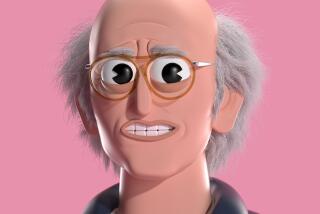‘Movie Crazy’: Harold Lloyd’s Top Talkie
- Share via
True discoveries in American movies are rare anymore. But the UCLA Film Archive comes up with something special Thursday: the restored version of “Movie Crazy,” an excellent Harold Lloyd sound comedy, complete with 14 minutes missing since 1949.
Even in its shorter version, “Movie Crazy” is widely regarded as Lloyd’s top talkie, despite competition from films by Leo McCarey and Preston Sturges.
While Lloyd’s thin voice and modest oratorical gifts didn’t doom his career, they took it several notches down from his silent-movie glory days. But “Movie Crazy,” full of inventive slapstick gags, equals some of his best previous work.
It gives Lloyd his usual role: the bespectacled small-town go-getter, accident-prone but resilient, and in this case so enamored of The Movies that he persists in improbable attempts to become a matinee idol despite endless mishaps and rebuffs. His co-star, playing his cinematic ladylove, is Constance Cummings, the ghostly wife in the 1945 Noel Coward-David Lean “Blithe Spirit.”
Fascinatingly, “Movie Crazy” reveals a filmmaker largely overlooked, even though he co-directed an undisputed comic masterpiece, “The General.” Clyde Bruckman, “Movie Crazy’s” director, was Buster Keaton’s collaborator through the ‘20s, co-writing, among others, “Sherlock, Jr.” and “The Navigator.”
His directorial career lasted only a decade, but he also made superb Laurel & Hardy shorts (“The Battle of the Century”) and two W. C. Fields classics (“The Fatal Glass of Beer,” “The Man on the Flying Trapeze”). According to Katz’s Encyclopedia, a destitute Bruckman killed himself in 1955 with Keaton’s pistol after eating a last restaurant meal he could not afford.
“Movie Crazy” owes much to Lloyd’s special genius; he was a co-writer. But Bruckman’s hand is just as apparent. It’s a film with unusual “backstage” atmosphere, impeccable timing, incredibly mobile camera work and highly distinctive and intricately choreographed long takes. Rediscovering Bruckman may be unnecessary; his movies have been giving us pleasure for years, even if we tend to ascribe them almost wholly to their comedian stars. But the complete “Movie Crazy” is a find to cherish.
On the same program: “Hollywood Rhythm,” a bizarre “backstage” look at songwriters Gordon and Revel, some 1932 Hearst Metrotone newsreels and an unusually lewd 1932 “Flip the Frog” cartoon by Walt Disney’s ex-”Mickey Mouse” collaborator Ub Iwerks.
Information: (213) 206-FILM.
Although Iraq has far eclipsed it in public consciousness, the civil war in El Salvador rages on as Monola Wali and Pam Cohen’s brave documentary, “Maria’s Story,” demonstrates. Screening Tuesday at Melnitz, it’s an obviously sympathetic, but invaluable, inside look at the Salvadoran guerrilla movement, shot with small-format video mostly in rebel territory. It centers on a campesina, Maria Serrano, whose sad, uprooted life offers a cogent portrait of the rebellion’s history.
Melnitz’s week is rounded out with two beautifully photographed but irritating New Zealand films. Sam Pillsbury’s 1982 “The Scarecrow” suggests the kind of movie Steven Spielberg might make if his mind were more off-color. Set in the 1950s, it’s a disturbingly whimsical tale of two young boys whose high jinks are counterpointed with the peregrinations of a local sex murderer, played with stubbled, magnetic scabrousness by 76-year-old John Carradine.
Even more richly photographed, by Alec Locke in gorgeously rocky, mountain territory, is Leon Narbey’s 1987 “Illustrious Energy.” Otherwise, it’s a lugubrious tale of three Chinese immigrants, who have struggled for decades to accumulate enough gold dust to emigrate home. Speech is sparse and slow; events few and symbolic.
More to Read
Only good movies
Get the Indie Focus newsletter, Mark Olsen's weekly guide to the world of cinema.
You may occasionally receive promotional content from the Los Angeles Times.







